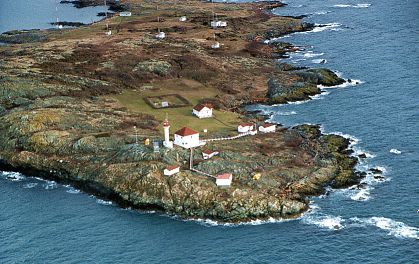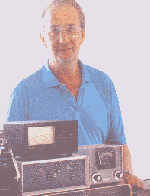|
|
|
Trial Island Lighthouse & VE7DQA
|
Photographed in early May 1996. Established (with fog horn) in 1906. This light is used to guide
mariners entering the Haro Strait from the Strait of Juan De Fuca, as well as those travelling
through Rasario Strait and Admiralty Inlet. Unfortunately, it was an overcast day and the photo
shows a definite lack of sunshine for that May day. The station is close to Victoria and the islands
are home to antennas for the city's local radio stations.
There is a current campaign in Canada to automate the lightstations. Much to the chargrin of many!
We don't know if this one is slated to be automated in the next five years, but one shouldn't be
surprised if that should happen.
 "Keeper of the Light"Percy Pineault, VE7DQA
"Keeper of the Light"Percy Pineault, VE7DQA

- PERCY'S STORY -
"Many Joys and Challenges for Trial Island Lightkeeper"
A typical day at the Coast Guard Light Station on Trial Island, off Victoria, BC starts at 6 a.m.
and ends at close to midnight.
That's when I'm on "dayshift," which starts officially at 12:30 p.m. If I'm on "night
shift," which starts at 3:30 a.m., I start at 2:30 a.m. and call it quits at about 7
p.m.
During the course of the day, repairs are carried out as needed, and routine maintenance is
performed (see "Duties" list at the bottom of the page).
We are fortunate to be able to set our own pace and priorities, which leaves time between station
duties to pursue hobbies, go fishing, or just relax and enjoy the peace and solitude.
I spend my spare time with Amateur Radio. The population of this island is three people in two
residences, 600 feet apart, so there's no problem with BCI or TVI. It's a great location for
hamming.
Because of the oddball hours I keep, I can be on the air just about any time of the day or night.
When I'm on night shift, I usually play around on packet, checking for messages on the BBS that I
use (WA6LYZ.#WWA.WA.USA.NOAM), and reading whatever appeals to me.
I don't usually go on the air as it's too hard to find someone to talk to in the early hours of the
morning. I tend to operate between 0600 and 2200 PST around 14.084 to 14.090 on RTTY, and 14.160 to
14.180 on SSB every day for a few hours. I also have a regular sked with VE6CHL in Lethbridge, where
my daughter lives.
Now and then, I get on CW wearing my earphones but as I have to monitor other frequencies at the
same time, I can't do this often.
RTTY works best for me as I can wander round the shack checking for fog, sea conditions or emergency
flares while the other station is transmitting, without missing anything.
I use an IC-720A for RTTY and a TS-830S mostly on SSB and CW. My homebrew linear uses a pair of
4-400s running about 550 watts out on RTTY and 1,400 watts on SSB.
The demodulator is a homebrew TU-1000 that features a variable shift so I can copy signals with 50
to 900 cycle shift on RTTY, ASCII AMTOR, with wide and narrow filters allowing PACTOR operation.
Tuning is done with a homebrew scope.
The antennas are a Hy-Gain 14AVQ vertical for 10 through 40 metres, a 75-metre Zepp fed with 300-ohm
TV twinlead (nothing else was available) through a homebrew Ultimate Transmatch, which is used on
17, 30 and 160 as well as 75 metres.
Because there is a lot of helicopter traffic in and out of here, I have to be careful what I put up,
and where.
There is talk of automating these stations. This lighthouse is a half-mile south-east of Victoria,
and has a 10kW AM broadcast station (CFAX), so we have "shore power."
If we lose it, our diesel generators will automatically take over. There are two generators used to
supply power to the light and the foghorn. The light is an industrial quality, precision-made 500
watt incandescent bulb that looks similar to an 813 tube.
With the lens magnification, the light is visible for more than 25km. The foghorn puts out a
300-cycle tone at 1 Kw (125 db at 25 feet). Power for our houses (and ham rig) is supplied by a 9.5
Kw generator.
People often ask if my antenna is on top of the lighthouse but it is not. The tower is too far away,
and it's directly in line with the helicopter landing area. So the antenna is ground-mounted as
close to the salt water as I could get it. I have one radial that may or may not be in the salt
water, according to the tide at different times of year.
I really love this way of life and the solitude. Even being single and out here by myself hasn't put
a damper on it. Some people I talk to tell me they are envious.
It might be OK for a ham, but I suspect most couldn't handle the isolation at some of the stations
for any length of time. This station is close to Victoria so I can go ashore almost any time I want
but I consider going ashore more of a hardship.
Necessity dictates that I go ashore for groceries, laundry, mail and sundries but I avoid it as much
as I can. Because of having to catch the tide, or when fog moves in, I literally have to run
everywhere as my time is so limited. By the time I get back I'm worn out from all the running
around.
We are self-contained out here. Houses are heated with diesel fuel, as that's what powers our
generators. We have a 1,800-gallon tank of it. A septic system using salt water takes care of our
sanitary needs. Fresh water is obtained by collecting rain from eavestroughing to a 6,500-gallon
cistern in the basement.
I used to do a lot of homebrewing, but had to give it up for some time. Now that I have the time and
the facilities, I intend to get back to it. The 813 amplifier - the ninth one I've built - is
strictly a make-work project for when weather and band conditions are lousy.
I'm also waiting for some software and information to enable me to get on SSTV.
I don't have to worry about BCI/TVI like a lot of landlocked stations but there are disadvantages
such as not having access to parts, like a rotary bandswitching mechanism for my IC-720A.
For those interested in the Canadian Island Award (I'm BC-104), I can be found on the
above-mentioned frequencies and modes. I also get on 14.260 to work the island-hunters from time to
time, not as often as I should due to the pile ups and the resulting QSLing.
Incidentally, I only QSL to those sending an SASE because of the prohibitive cost of cards, stamps,
envelopes and the hassle of going ashore to get stamps. I can't just run to the corner
store!
Trial Island Lightkeeper duties:
- Weather reports every three hours;
- Monitor station/foghorn equipment;
- Maintain buildings and grounds;
- Carry out station security;
- Maintain and service boat;
- Maintain firefighting readiness.
Unpaid duties:
- Assist RCC in Search and Rescue;
- Coast watching;
- Refuge for mariners in distress;
- Show public around station;
- Whale-watching and reporting;
- Monitor emergency VHF channel 16;
- Park warden for sensitive rare plants.
My thanks to Percy, VE7DQA, and "The Canadian Amateur Magazine" (R.A.C.) for the above story.
Lightouse pictures courtesy of lighthouse photo journey.
Percy's picture "scanned" by Karyn Hand.
|
|

